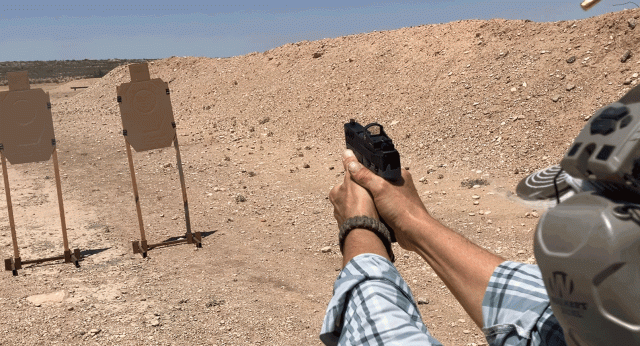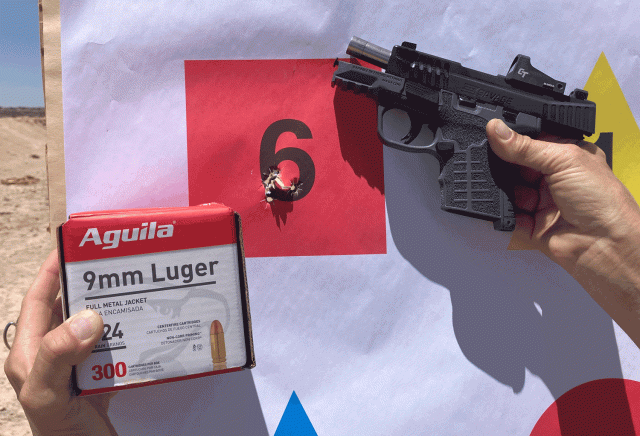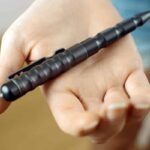Savage Arms made waves a few seasons ago when they announced their first handgun. At least it was the first in my shooting lifetime, from a company that’s built a brand on quality rifles. That handgun, the Stance, has since been updated to a new line called stance XR. As with Savage’s rifle lineup, the Stance XR shows all the signs of keeping up with the times in terms of features.
Why do I call the Stance XR edition a sophomore? As the company’s only pistol, the 9mm Stance XR is in its second rendition now. According to my sources, the design of the pistol is based on the former Honor Guard by now-defunct Honor Defense. Having previously tried an Honor Defense, I believe this to be true. But, Savage Arms has stayed true to its habit of keeping with the times and the new XR design is quite changed from the first, and thoroughly updated, with one (I think) unfortunate exception in the top-of-the-line XP variant.
What is the Stance XR?

The Savage Stance XR is a carry-oriented, 9mm striker-fired pistol with a polymer lower. Of course, it joins a very big field of competitors, but manages to have unique and attractive features in that space. As carry guns go, it’s on the larger side of the unofficially labeled micro compact class, or perhaps a small entrant among subcompacts. It has a 3.2-inch barrel and 10+1 or 13+1 capacity. Both magazines are included.

The XR replaces the plain Stance pistol in the Savage lineup. It’s available in several trim packages, with and without a manual safety in some cases; optic-ready and not. This updated model has numerous trim levels, but the biggest updates include lightening cuts on every slide. All feature a very grippy but not abrasive stippled grip. All have an ambi slide lock and magazine release (no changes required to use the left handed mag release).

The model I’ve been testing is the most costly option in the XR lineup, called the XP. It sports three-dot tritium sights that co-witness with a pre-installed Crimson Trace CTS-1500 red dot. Unlike other Stance XR options, there is also a non-optional manual thumb safety.
Consistent between every model in the XR line is an attractive appearance and a thin, slab-sided frame that fits most hands. The profile of the slide is on the high side, but the lightening cuts, modern stippling pattern, and range of finish choices offset the look of a bulky slide.
Shooting the Stance XR, XP model

This is a very compact gun that handles as much like a full-size 9mm as a tiny gun can. That’s a compliment. Thoughtfully designed magazine floorplates offer good pinky support for most hands, especially when using the 13-round mag. The pinch factor of seating mags, so familiar to just about anyone who’s run a micro-compact, is minimized. And the mags drop free regardless of load condition, a trait I consider essential in a carry gun.
Recoil isn’t as tame as the lightening cuts might make one hope for, but it’s not dramatically snappy either. This was a summer trial and I found the aggressive stippling very helpful on my sunscreen-coated hands. Control can further be enhanced by selecting the best-fitting of two choices of backstrap.
Manipulation of the controls is on the heavy side by modern standards. The slide doesn’t have the heaviest spring in the class (that distinction belongs to the original M&P Shield), but it’s not far off. The thumb safety seemed to break in a little with use, but is no pushover—a good thing considering it’s ambi; the force required offers some protection from unintentional disengagement. The slide stop is not within easy reach of my medium-size hand, making its release a two-handed task.
Speaking of the M&P Shield, another similarity is found with the metal magazines. A sliding polymer collar makes up for what would otherwise be a skinny spot between the mag baseplate and the bottom of the mag well. It looks just fine in the gun, but I find the movement of the collar and the oval (instead of half-oval/half-square) shape of the baseplate to be a mild distraction. Finding the direction of the cartridges in the mag by tactile method requires practice.

Accuracy and Reliability
We tested three 124 grain loads. The method was my usual warm-up routine: a slow, five-round group, fired from standing position with precision in mind, in this case from five yards.
In terms of accuracy, results were in a clear Win/Place/Show order.

In the Win category is affordable Aguila 124 FMJ ammo, yielding a tidy four-shot hole and a single hole a tad low and right—shooter error there. Holding second place is Hornady’s 124 grain with an XTP bullet, delivering a tight yet evenly scattered group. I admit I was a bit surprised by the clearly least accurate result from Federal American Eagle 9mm, a longtime personal favorite across calibers including rifle loads. Its scattered group is still perfectly good for defensive purposes, but at 50 yards, I would not trust it to land on a torso.
A Note On Accuracy Testing
A word, if I may, on so-called accuracy tests such as this. Let’s keep in mind that hair-splitting precision is not necessary and is perhaps even inadvisable in a defensive gun. Tests such as I did, performed from an unsupported position, are sometimes as reflective of the person behind the trigger as the gun’s performance. This is a casual trial and the results are general in nature. Any ammunition should first be tried in a specific gun before the user relies on it for any purpose.
Reliability testing was done using the Variable Pace Drill as promoted by Larry Vickers. The 50-round exercise puts function to the test in all the standard ways a defensive handgun might be asked to perform. The XR XP ran well. There were no feeding issues and the empty mags dropped easily and freely during reloads.
Incidentally, this was my first time running this three-target drill, and I found it to be a fun training exercise. If you’d like to see an article on it or on my favorite go-to drills, drop a comment.
The Optical Difference

The CT 1500 optic included with this gun is, so far, outstanding. Its motion-activated power has been perfectly dependable. Though its base ever so slightly overhangs the slide, it’s not obtrusive nor does it catch on the T-shirt I wore over the XP when doing my usual conceal-it-for-a-day test. This was a great choice on Savage’s part and gives me a bit of peace knowing what became of the optic after it was slated to be included with now-defunct SCCY’s DVG-1 9mm. I first met this optic three or four SHOT Shows ago on the DVG-1 and have since wished we’d see it more widely available.
Choices are great, but I don’t feel it was necessary to include multiple mounting plates for other optics with the Stance XR XP. The CT 1500 is sufficient. Nevertheless, if you’ve a pet carry optic, it’s likely one of the included mounting plates will fit. Since I didn’t change the included mounting system, I cannot comment on the quality of these alternatives.
Final Impressions
Savage Stance XR XP is a worthy consideration for a carry gun at a price that’s just north of moderate. For those who want a gun that not everyone else shows up at the range with, and is eye-catching enough to garner attention, it fits the bill. Shooting it is a pleasure, though I give it a B- in the handling department thanks to having a non-optional, bilateral thumb safety and (for me) an unreachable-with-my master grip slide lock.
As is almost always the case with new guns that are outside the Glock/Sig/Smith/Springfield mainstream, custom Kydex holster options are rare to nonexistent. And as always in that circumstance, I would look for JM4 Tactical’s Quick Click & Carry High Ride holster to solve my concealment challenge.
Have you seen the Savage Stance XR at your local store? Do you have time behind one at the range? Let us know your impressions.
Savage Stance XR Specs
Caliber: 9mm Luger
Capacity: 10+1 or 13+1 (two magazines included)
Sights: Crimson Trace CTS-1500 plus elevated three-dot tritium
Manual safety and trigger safety tab on XP model; manual safety optional on other models
Barrel: Stainless steel; 3.2 inches
Weight (with unloaded short magazine): 22 ounces
Overall Length: 6.5 inches; subtract approximately 0.25 inches for small backstrap
Overall Height With Optic/Short Magazine: 5.3 inches
Overall Height Sans Optic/Short Magazine: 4.75 inches
Width of Optic: 1.0 inches
Width of Gun: 0.9 inches
Frame Color: Black, Flat Dark Earth, or Gray
MSRP: $689 for XP; market prices in the $600 range
Read the full article here











